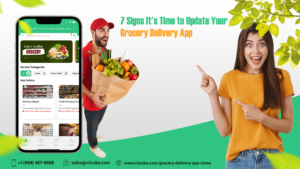
“How long does it take to build an on demand app?” Well, it is a common question that most aspiring entrepreneurs ask when thinking of launching an app-based business. Besides budget, the second most concerning aspect of launching an online on-demand service business is “time”. Determining the app development timeline and setting up a plan to achieve it is crucial.
Generally, developing a smaller and simpler app takes less time, while it takes months and even years to build a complicated one. Take Gojek Clone, for instance. It may take you several months to design, code, test, and launch the app because it offers multiple services under one hood. Another time-consuming thing that you would have to deal with is developing apps for different platforms, such as iOS and Android.
In short, you may have to spend at least nine months building a complex app!
Let’s explore the app development timeline in detail.
App Development Timeline
The time required to build a single or multi-service on-demand app varies greatly depending on its complexity. Therefore, whenever you ask about how much time it takes to build a mobile app, be it for iOS or Android, the answer varies depending on its feature density, design, and overall complexity.
The table below gives you a brief idea of the time it takes to build the apps based on their complexity.
| App Development Complexity | Required Development Time |
| Simple | 3-4 months |
| Average | 4-6 months |
| Complex | 9+ months |
This is only the average time bracket required for developing the application based on its complexity. A typical app development process also includes several phases like designing, coding, bug fixing, and market testing. No matter what kind of app you’re building, you cannot skip these phases.
Each phase has its challenges. You can take precautions, but there’s no guarantee they won’t happen. Therefore, before starting the app development process, you need to consider how you can minimize the risks and complete the project within the set timeframe.
Here’s a breakdown of the app development timeline:
1. Market Research (2-3 weeks)
The first step in on-demand app development is to research the market and validate your business idea. Even if you are sure that the app you’re about to develop will do wonders in the market and can help you make six figures in no time, you still need to study the market.
Researching your target market means you will be learning in-depth about the demographics of your audience, forthcoming trends, current preferences, and much more. It would be foolish to directly jump to app design and development.
At this stage, you have to work through three essential aspects:
- Validating the mobile app idea: Research to see if people are willing to use your on-demand app.
- Do SWOT analysis: The analysis involves critically looking at the strengths, weaknesses, opportunities, and threats that revolve around your business idea.
- Creating a product strategy: You need to outline the goals and objectives of building the on-demand app and what approach you will take to launch it in the market.
2. Prototyping (1-2 months)
Prototyping is an essential part of the entire app development process. This is officially the stage where you’re entering the app design phase! To put it in simple words, prototyping is creating a sample model of how your on-demand app will look and what essential features it will have.
A prototype is one of the best ways to test your app on the market and see if it will work or not. You can also ask your target audience to provide feedback on the app and help you find problems and improve the final product.
The process involves low-fidelity wireframing, which usually takes 2-4 weeks to complete if done correctly! But what is wireframing? Wireframing is creating a blueprint of the application that acts as a guideline for you when you’re creating the final product. During wireframing, build a visual guide wherein you decide the position of the buttons, text, pictures, etc.
3. Designing the App (2-3 months)
Once your low-fidelity wireframes and the prototype get a pass during the initial testing, you can move forward with finalizing the next steps. You can now create high-fidelity wireframes that include designing the final version of the on-demand app.
It may take you 2-3 months to design them since this process incorporates building UI kits for both the iOS and Android apps. After finishing off the designing stage, you can pass these wireframes to the developers so that they can start coding the on-demand application.
4. Development (3-6 months)
The app development stage takes the longest time. After finalizing the designs, the developers start working on coding the application and ensuring that it’s free of any errors. Usually, the entire development stage is divided into smaller sprints or milestones to make it easier for the developers to get the work done by following a strict deadline.
There are three sub-stages of development:
- Back-end development: The app’s back-end handles important tasks like organizing and storing the data. It also assimilates the server, database, and logic that are essential for the app to function properly. It may take you 3–6 months to build the app’s backend.
- Front-end development: The app’s front-end includes elements that users interact with, such as the layout, functions, and design. It can take you 3–4 months to build the front end.
- API Integration: Application Programming Interface integration means connecting different software systems so that they work seamlessly. If you’re performing a simple API integration, it might take you a few days, but if you’re working on a complex integration, it can take you 1-2 months!
5. Testing the App (3–4 weeks)
Before launching the application, you need to test the app and see that everything’s working fine and that it’s bug-free! The QA team runs a set of tests to check the code, the security of the app, and its functionality. Nowadays, the team runs automated testing, which takes 3–4 weeks. However, in the case of manual testing, it can consume up to 2–3 months of your time.
The time bracket can greatly vary depending on the size and complexity of your on-demand app.
6. App Launch (2-4 weeks)
Before launching the final version of the app on the iOS and Android App Stores, you need to undertake beta and alpha releases. The alpha release refers to the app’s “early pre-release.” Here, the app development company’s testers use the app for some time to figure out what’s missing or what adjustments need to be made. Beta release or testing, on the other hand, is performed by end users.
Well, all of this happens pre-launch of the application, along with the app submission and review by the Google Play Store and Apple App Store. Since these app stores have different reviewing processes, it may take you at least 2-4 weeks to finally launch the app.
Well, that’s a lot of work! But, with a few clever tips, you can reduce the app development time. Let’s learn how.
How to Reduce On-demand App Development Time?
Here are some of the smart ways you can reduce development time and ensure a quick app launch.
1. Using low-fidelity wireframes
It’s a clever way to reduce the time associated with app development because it allows for quick iterations and also facilitates early feedback. Low-fidelity wireframes are cost-effective and give the designer team a basic structure of the application, which they can use to add visual details later.
2. Building an MVP
MVP, or Minimum Viable Product, can reduce the app’s development time, as it enables you to launch a basic version of the app and not a fully-fledged one. The app integrates only essential features and services (if you’re building a multi-service on-demand app). It’s a great way to launch the app first and then use the early user feedback to add other required features or high-demand services and improvements. Besides saving time, an MVP can also save a lot of money.
3. Buy a ready–made app!
Buying a ready-made application can help you launch a fully-fledged on-demand app in just 1-2 weeks! Yes, you heard it right! A pre-built application is already designed, coded, and tested. All you have to do is white-label, integrate the features you want, and launch it in the app stores!
There are white-label firms that provide you with ready-made packages, which include scripts for a website, an admin panel, and other support panels along with the applications. The best thing is that their professional app developers rebrand the app, add in all the elements that you want, run final tests, submit it, and launch it too!
In short, investing in a ready-made application means you don’t have to struggle through all the different app development stages you just read about in the blog. You can quickly go live and start earning money from all the service bookings on your on-demand application.
It’s that easy.
Wrapping Up
Developing an app from scratch still takes months, even when you have ready-made templates, advanced technologies, and high-end systems! If you are someone who wants to launch on-demand apps, be it for taxi booking, food delivery, carpooling, or a multi-service platform, you should consider investing in white-label solutions.
White-label apps also give you the flexibility to choose your revenue-generation stream and integrate preferred languages, currencies, payment gateways, etc.
In brief, a ready-made app is the best way to kick off your online app-based business because it can save you months of hard work! Moreover, nothing’s better than getting the early bird benefit of earning money and capturing the market while your “future” competitors are still busy building their apps.







